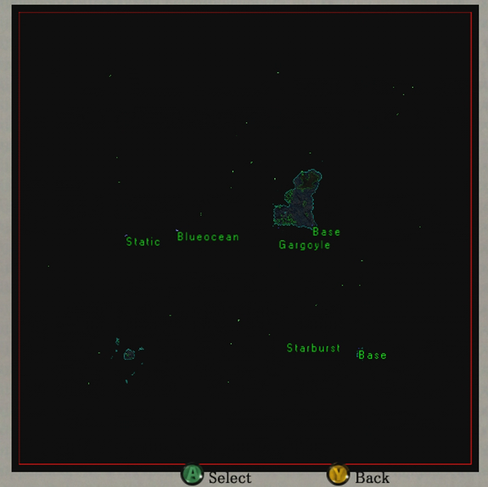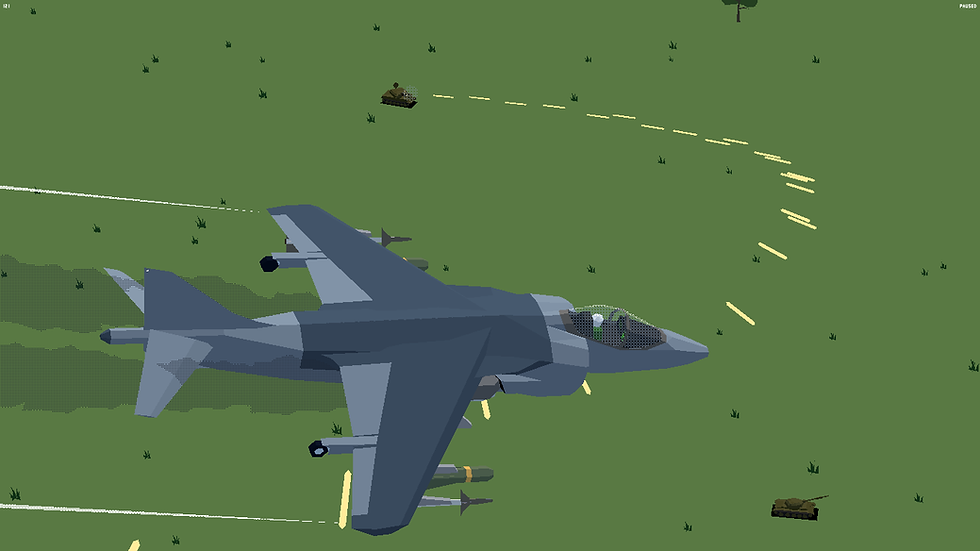Over G Fighters: Appreciating Arena Mode
- Aaron "Ribbon-Blue" Mendoza

- Oct 30, 2021
- 7 min read
Updated: Sep 22, 2022

This opinion is probably a decade and a half late, but Over G Fighters is such an excellent flight-sim lite. When I was forced to notch an incoming AAM-4 while I was guiding an AIM-54A before its radar went active, I realized there was much more to this game than expected. However, I specifically find myself interested in a standalone, non-story-related game mode that inspired a developer for a highly anticipated flight sim lite currently in development.
When Over G Fighters (June 27th, 2006) was new, I was busy participating in squadron matches and tournaments in Ace Combat 6: Fires of Liberation. The name Over-G had been mentioned in the lobbies between rounds and discussed during chill flights, but I never felt the need to dive into what was always described as a lackluster, slow-paced game. Fast forward 14 years or so, and my interest in this game was piqued after an interview with Why485, the developer of Tiny Combat Arena:
"Tiny Combat Arena began as something of a dare from Mike Dolan. The idea was based on an almost throwaway mode from the Xbox 360 game, Over G Fighters." - Why 485.
He went on to describe the game mode in more detail. Since then, I've had Over G Fighters on my list of titles from the past to give a serious playthrough. In fact, this statement is the only reason I am genuinely interested in this game for the first time ever. How could it have inspired something like the now sought-after Tiny Combat Arena?

To put things in perspective, even though it was released as a console-exclusive, Over-G Fighters does a rather admirable job of being the best combat flight sim-lite on the Xbox 360. Many moderately realistic features make up the core of its gameplay. Realistic hardpoint management, aircraft part damage, fuel burn rates, turn rates, blackouts, red outs, over-stressing the airframe because of aggressive maneuvering, etc. I found it relatively easy to complete entire sorties using the instruments in the cockpit and the general user interface.
It is the Arena mode of this game where the magic happens. There is an offline single-player and online multiplayer version of the Arena.
Offline Arena Mode

This open-ended game mode is a mixture of wave survival, and high score focused. With no set objective, players are free to select any aircraft, choose their own targets and fly multiple sorties going anywhere they wish with the restrictions of a flight simulator. The realistic limits on fuel, weapons, and aircraft performance transform the gameplay from an objective, limited approach to something more free-flowing but strategic. There is no winning by bombing a specific building or shooting down a particular attacker. Wisely choosing engagements, making every weapon count, using altitude and speed advantages to navigate over long distances and still leave enough fuel to return to base and do it all over again defines this game mode.
In offline single-player Arena, the player launches from an island near the middle of a massive map. Even taking a fuel-efficient aircraft like a Boeing F/A-18 Hornet or a super cruising Lockheed Martin F-22A Raptor is not enough to do a lap around the border of the entire map without some difficulty. There simply isn't enough fuel to cover all of that area, even if you avoid all the hostiles. And let us be clear, there is an overwhelming amount of them. The map images shown below layout the locations of aircraft, airfields, islands, ships and known higher priority targets. Every dot on the zoomed out map (left) is an enemy of some sort (right, zoomed in image).
There are roughly six areas that have warships and aircraft loosely grouped together. The groups are defined by the territory they occupy and the general type of aircraft in the area. For example, multiple attackers at low altitudes and United States Navy aircraft over the ocean near warships. Though a majority of the enemies operate in those areas, there are still unexpected opponents that fly wherever they please. Even if you are in combat against Chengdu J-7s, it is still possible to be ambushed by a Lockheed Martin X-35; which happened to me while I was flying a Grumman F-14A Tomcat. Not recommended.
Intermixed with these groups are "bosses" like strategic bombers, Iowa-class battleships, stealth aircraft, and AWACS. As enemies are defeated, the player accumulates glory points. The more difficult the enemy is dictates how many glory points are given for defeating them. This further adds to the mission planning in this free-form game mode.
This makes interceptor sorties focused on destroying an AWACS near the farthest reaches of the map even more valuable than defeating a flight of fighters singlehandedly. Planning out flight paths to evade patrolling enemies and hitting high-value targets before their escorts swoop in changes the dynamic of offline Arena. Frequently using high speed and high altitude to traverse the map is immensely helpful. Learning how to safely approach the hostiles and when to engage and disengage is the key to success.

As glory points are gained, in-game titles like "Green Horn," "Tactician," "Ace Sniper," and "Ultimate" are given as rewards. Achieving higher titles unlocks opportunities to fight big bosses (ace pilots) after certain conditions are met, like destroying a number of a specific type of aircraft in a particular area. Defeating big bosses will unlock their aircraft for the player and eventually lead to yet another game mode to be unlocked.
There are few allies to assist the player. Their wingman, who flies an aircraft and weapon loadout decided by the player, can make all the difference in the offline Arena. As their weapons are also limited, utilizing the wingman means more in Over-G Fighters than many other flight games that were also on the Xbox 360. Intelligent use of the wingman includes having them engage escorts while the player attacks high-value targets or setting the wingman to perform air-to-surface strikes with the player flies escort.

The offline Arena does have airfields and a carrier battle group that can rearm, refuel and repair aircraft... if you can survive long enough to reach them. The glory points gained will be lost or reduced otherwise. In this regard, running out of fuel far from base is just as deadly as getting hit by a missile. Landing, resupplying, and launching back-to-back sorties are the best ways to earn high amounts of points over time, making survival paramount.
While offline Arena ends with either the player's death or manually ending the session, the online multiplayer version of Arena is a somewhat different beast.
Online Arena Mode

Online, four teams of up to two players each battle to be the last team standing. Each team has an airbase with air defenses, a symbol tower (headquarters), and an aircraft carrier with destroyer escorts. Defeating an opposing team is done by destroying their assets, especially the symbol tower, which removes an opposing team from the match when it is destroyed.
Glory points are still collected in online gameplay by defeating other players and computer-controlled units. The destruction of a symbol tower gives an apparently massive amount of points unironically labeled as "Gained more glory points than I can imagine!!!"

Intercepting incoming attackers while pressing the offensive against high-value targets is a balance that relies on player skill and coordination. Enemies cannot be found at long distances by pausing the game and scrolling through the map like in offline Arena. The long-range radar shows a general idea of where enemies are, but identifying aircraft and obtaining a radar lock is noticeably harder in online play.
Learning each aircraft's strengths and extra functions (and bugs!) is a deep part of the PVP in online Arena mode. These functions vary from aircraft to aircraft. For some, they are simple additions like a hook for landing on aircraft carriers. For others, it's a dogfight mode that allows for guns and missiles to be fired simultaneously, super search radar modes, or radar stealth abilities. In one peculiar case with the Sukhoi Su-33 Sea Flanker, it's learning an exploit that combines disabling the angle of attack limiter while gaining speed on the runway, then performing a Pugachev Cobra during rotation for takeoff, forcing the Flanker to climb in a wholly unnatural way that results in an immediate altitude and speed advantage no other aircraft could match.
Unfortunately, this is all I could gather from the multiplayer Arena, but considering this game's age and the unlikely chance for re-release, it's doubtful maximum capacity online lobbies would ever happen naturally.
I was able to gather a bit of information and experience in online play thanks to the assistance of RaptorDad86, a flight simulation-focused content creator who has much experience with this game. Thanks to him for supplying me with information about the height of online multiplayer gameplay and even flying with me to help create this article.

Newfound Respect and Understanding
Even by today's standards, the open ended Arena game modes of Over G Fighters would still be stand out additions in similar flight simulation or flight arcade games. They would be a considerable selling point advertised on social media, crowdfunding projects, pre-orders and video trailers.
Thinking back to Tiny Combat Arena's popular 2019 demo builds, the inspiration is evident. But to be clear, it's not just a lazy copy. Tiny Combat Arena's development towards the full-scale game go far beyond the intentions of Taito, the developer behind Over G Fighters. its approach to open-ended flight sim lite gameplay is firmly its own concept that has nods to this game from 2006 but does not plagiarize it.
This entire journey to scratch a curious itch about Over G Fighters has sparked my interest in it and the Energy Air Force series which it is associated with. It feels like a new exploration into game console-based flight sim lites is just beginning for me.
About the Writer
Aaron "Ribbon-Blue" Mendoza

Co-founder of Skyward Flight Media. After founding Electrosphere.info, the first English Ace Combat database, he has been involved in creating flight game-related websites, communities, and events since 2005. He explores past and present flight games and simulators with his extensive collection of game consoles and computers. Read Staff Profile.




































.png)